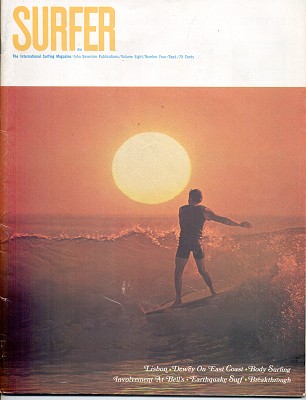
surfresearch.com.au
nat young : the paddle -out entry , 1967.
nat young : the paddle -out entry , 1967.
|
|
|
|
|
|
 |
surfresearch.com.au
nat young : the paddle -out entry , 1967. |
|
The
Paddle-out Entry - another step toward total
involvement.
Page 78by Robert "Nat" Young Returning from the World Surfing Championships in San Diego last November, I found I was in a surfing rut. I had no new ideas on practical surfing and only mild inspiration from George Greenough, who had worked out some new ideas on bottom shapes and fin design. So, with Gordon Woods, I designed a new board. When I saw the result, I had my inspiration — "radical" was the only word to describe this new little animal. Its statistics in length, thickness, and width were similar to "Sam," my World Contest board, but the bottom shape was completely new. Directly in front of the fin, the board had a definite V-bottom. This made the board so sensitive that it felt like one's first drive in a fast car, or climbing on an untamed stallion. It was so sensitive and fast out of the turn that you could not maintain your balance no matter how hard you tried. Provided you made the turn in the first place — an accomplishment in itself. So now, I definitely had my inspiration. I could not ride this new board —it was either improve my surfing or give up. These bare facts made me smarten up, and I started surfing and think¬ing as much as possible in order to beat this little dictator. Just before I left for the Makaha Contest, the results were starting to roll in. In order to make this board work, I had to make everything harder. I found myself deliberately trying to make takeoffs over the falls. However, I had the feeling that I wasn't near the limits of this board. So I thought just how deep and involved I could place myself and still beat the wave. The logical answer was to start the wave further back —at a point nobody else ever had attempted. I worked out on paper that if I improved my timing, I might be able to pick up the wave while still in the throes of paddling out! While paddling out through the lineup, I stroked furiously up the face of the wave towards the shoulder, and as the wave broke over me, stood up on the outside rail and fell with the curl to the bottom of the wave — thus achieving the perfect late entry. The whole thing was much easier on paper than in practice. I seriously hurt myself, and at that point, it looked as if the whole thing had just been a beautiful paper idea. Then one day, three days before I left for Makaha, I was away for a surfing weekend up the coast and the thought dawned on me: it may be better to try another step toward total involvement the same maneuver facing into the curl instead of paddling for the shoulder! First time I tried it, it was a tremendous success. After all my failures, I was overwhelmed. The taste of doing something I had dreamed about inspired me to search deeper into the problem. I left for the Makaha Contest and tried the maneuver in Hawaii. I pulled it off only once, I guess as a fluke, in the Makaha shore-break. But upon my return to Australia, I pressed on and attempted it whenever the position presented itself. I now am astounded by my recent success. Catching a wave paddling out seems to answer a lot of my problems if done practically, not as a stunt. It must be one of the best acceleration movements on a surfboard because you utilize the wave's force at its most powerful stage; in fact, you store up enough power to insure the perfect bottom turn. Like any other manoeuvre in any other sport, timing and positioning are the most important factors. Positioning comes into account while paddling through the lineup. I had to make the decision on exactly which wave, and then by rising to the nose and aim the board diagonally up and at the point of the curl. I found it best to hold off on the paddling and then take extremely deep strokes to produce brutal acceleration aimed completely at the curl. On the last stroke, I leaped to my feet and took up a normal turn position, except that I leaned way down the wave and virtually dragged the board over the curl with me. This is perhaps the most difficult and touchy point, but I find, providing my normal turning stance is maintained at all times, it is much easier. Upon reaching the base of the wave, if the feet are in this normal turning position, it is merely a transfer of weight from the already adopted out and down the wave to the normal turn position and leaning directly into the face. The trouble is, the rest of the wave tends to become a kind of anti-climax. Still, it does answer my initial problem of getting deeper in the wave, and not for one minute am I going to suggest that this maneuver should be practiced (sic) as a gimmick! If practiced (sic) as a stunt like spinners, riding backwards, coffin riding, or any other gimmick, the whole ideal will be lost. It is merely a practical answer to my problem of getting deeper and more involved in the wave and just a step on the way to total involvement. |
1. 2.  3.  4.  5.  6.  7.  8.  |
Surfer Volume 8 Number 4, September 1967. |
 |
|
|
|
|
|
|